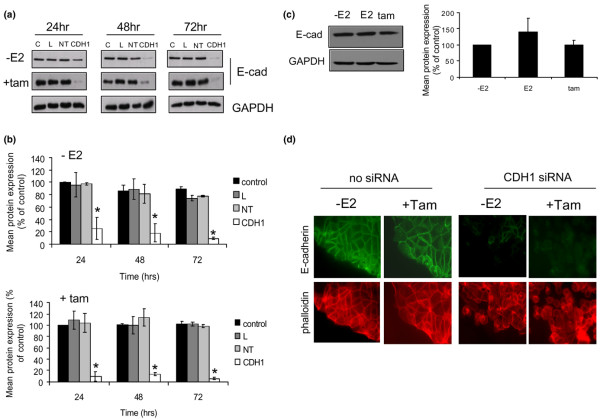Figure 2.
Modulation of E-cadherin expression in MCF-7 cell using siRNA. (a) MCF-7 cells were left untreated (control, 'C') or treated with transfection lipid ('L'), non-targeting (scrambled) siRNA ('NT') or E-cadherin-specific siRNA ('CDH1') for the times indicated in the presence or absence of tamoxifen. Cells were then lysed and the lysates probed for E-cadherin. (b) Densitometry analysis was performed on three separate sample sets and plotted as mean percentage change ± standard deviations *p < 0.05 versus control. siRNA treatment significantly inhibited E-cadherin expression over a period of 72 hours irrespective of the presence of tamoxifen. (c) To determine whether E2 or tamoxifen-modulated E-cadherin expression, cells were treated with E2 or tamoxifen, lysed and probed for E-cadherin and β-actin. Neither E2 nor tamoxifen significantly altered E-cadherin expression in these cells. (d) MCF-7 cells were treated with plain medium (oestrogen free) or CDH1 siRNA for 72 hours in the presence or absence of tamoxifen before immunofluorescence staining of E-cadherin (green) and actin (red). Cells were then visualised by fluorescence microscopy and representative pictures taken of the same field of view using fluorescein isothiocyanate (FITC) and TRITC (Tetramethyl rhodamine isothiocyanate) filters. Very little or no E-cadherin was detectable after siRNA treatment. Inclusion of tamoxifen alongside the siRNA appeared to increase the numbers of cells having a spherical morphology.

